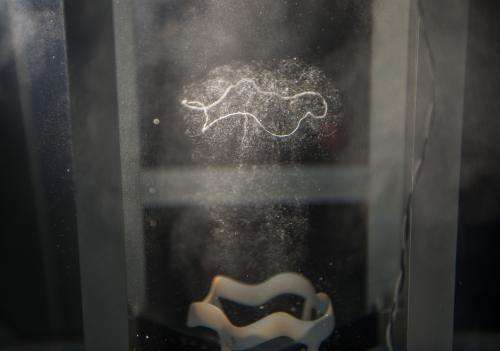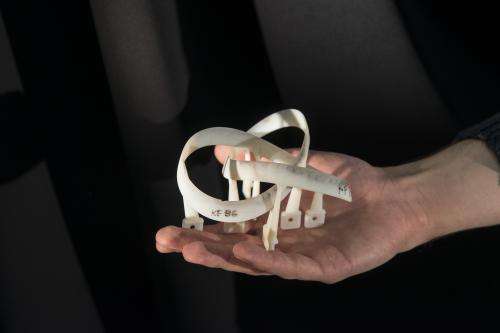March 4, 2013 report
Physics duo create first knotted vortex in a fluid (w/ video)

(Phys.org) —Physicists William Irvine and Dustin Kleckner of the University of Chicago, have for the first time, created a knotted vortex in a fluid. They describe how they printed 3D airfoils and then accelerated them very quickly in a tank of bubble-filled water to accomplish this feat in their paper published in the journal Nature Physics.
Vortices occur throughout nature, generally in the air or in water. They occur due to human activities as well, such as with smoke rings blown from the mouth or when they form around an airplane wing. In the latter case, two vortices are actually created when a wing suddenly accelerates, which circle in opposite directions. It was this latter phenomenon that led to this new effort whereby the team was able to create vortices that were formed in the shape of knots. Knots, like vortices, are important to physicists, because they too occur in nature, and because they are believed to play a fundamental role in the workings of both quantum and classical physics.
Scientists have long believed that it should be possible to create knotted vortices in a liquid, going back to the days of Lord Kelvin who suggested that atoms were possibly the knots that held the ether together. But until now, no one had ever accomplished that feat. To make it happen, Irvine and Kleckner created very small airplane foil wing replicas using a 3D printer. They submerged one at a time in a tank full of water that had been caused to be riddled with very tiny bubbles (to make the vortex visible) using an electrical charge. Next, the airfoil was yanked very quickly forward a very small amount, causing the water behind it to be pulled forward into the space vacated by the airfoil—since the airfoil had been formed in the shape of a knot, the liquid vortex took on the same shape, if only momentarily. To video-capture their results, the two set up a high-speed laser scanner that allowed for filming the liquid knot in all its three dimensional glory.
Now that it's been proven that knotted vortices can be created in a liquid, and a way to do so shown, researchers in the future will be able to create them on as as-needed basis when attempting to model them in such settings as the sun's outer atmosphere, the creation of superconductive materials or as a means of describing sub-atomic particle behavior.

More information: Creation and dynamics of knotted vortices, Nature Physics (2013) doi:10.1038/nphys2560
Abstract
Knots and links have been conjectured to play a fundamental role in a wide range of physical fields, including plasmas and fluids, both quantum and classical. In fluids, the fundamental knottedness-carrying excitations occur in the form of linked and knotted vortex loops, which have been conjectured to exist for over a century. Although they have been the subject of considerable theoretical study, their creation in the laboratory has remained an outstanding experimental goal. Here we report the creation of isolated trefoil vortex knots and pairs of linked vortex rings in water using a new method of accelerating specially shaped hydrofoils. Using a high-speed scanning tomography apparatus, we measure their three-dimensional topological and geometrical evolution in detail. In both cases we observe that the linked vortices stretch themselves and then deform—as dictated by their geometrically determined energy—towards a series of local vortex reconnections. This work establishes the existence and dynamics of knotted vortices in real fluids.
Journal information: Nature Physics
© 2013 Phys.org


















